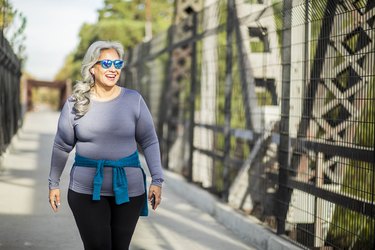
When it comes to effective workouts, high-intensity interval training (HIIT) gets plenty of attention — and for good reason. That style of workout has been linked to numerous benefits for mental and physical health, including improved cardio fitness and better metabolic function.
But only doing HIIT — particularly multiple days a week without a rest between — isn't recommended because it may lead to higher risk of overtraining injuries and general fatigue. If you're looking for a good complement to throw into your fitness mix, or you want an alternative to HIIT altogether, that's where LISS cardio can come in.
Video of the Day
Video of the Day
What Is LISS Cardio?
Short for low-intensity, steady-state cardio, LISS refers to a low level of exertion — that means a moderate pace — done for a continuous and period of time, according to Ronny Garcia, CPT, a trainer at Blink Fitness.
Some common LISS cardio examples include walking, hiking, swimming, kayaking and cycling, Garcia tells LIVESTRONG.com. And if you're wondering, what is the best form of LISS?, it's the one you enjoy the most and feel motivated to do.
HIIT vs. LISS: What's the Difference?
In many ways, these are opposite approaches, according to Garcia. HIIT relies on short bursts of intense effort along with brief rest periods, and the workout is usually done in under 20 minutes. LISS is a meant to be done in a continuous timeframe with the same level of effort throughout.
It's important to note that you don't need to choose one approach and stick to only that for your fitness, adds Samantha McKinney, CPT, trainer at Life Time Fitness.
"These can complement each other, because HIIT builds fast-twitch muscle fibers and is important for power and strength," she tells LIVESTRONG.com "It's associated with more intense work at higher heart rates, relying exclusively on carbohydrate stores and the energy between creatine and phosphate bonds for fuel."
By contrast, she says LISS is less stressful on your body and the lower intensity can be sustained for long periods of time — from 30 minutes to several hours.
"I often encourage HIIT sessions for those clients who never ramp up their intensity to the point that they feel uncomfortable, and I'll emphasize LISS in clients who chase intensity and an adrenaline high from every workout to slow them down a bit," McKinney says. "But ultimately, I recommend doing both. You can't replicate the benefits of LISS with HIIT and vice versa."
She adds that training across all intensities builds metabolic flexibility so your body knows when it's best to burn fat, when it's best to burn carbs and when to switch between the fuel sources. HIIT utilizes the phosphagen and fast glycolysis anaerobic energy system, which creates energy by burning carbs. LISS utilizes the aerobic energy system, which converts fat into a fuel source.
"The combination will drive health and results from any training style," she says. "Balancing these intensities has also been shown to improve energy and mood."
LISS Cardio Benefits
LISS training promotes better body composition — more muscle mass and lower body fat — because it trains your body to use oxygen more efficiently, McKinney says. That also provides a boost for improving muscle recovery overall. (It's important to note: While HIIT scientifically burns more total calories than LISS, HIIT burns more calories from carbs while LISS burns more calories from fat.)
"Think of it as a way to grow the size of your metabolic engine so you can do more work with seemingly less effort across all intensities," she says. "Building this system helps your body learn to recover between higher-intensity training intervals and between strength training sets."
The steady-state nature of LISS also improves your heart health, per a small October 2015 study in the Journal of Strength and Conditioning Research, boosting blood flow and heart regulation, Garcia says. Those physical advantages have been shown to lower risk of high blood pressure, diabetes and some cancers, he notes.
"Another advantage is that LISS can be beneficial to those who find it challenging to maintain a HIIT pace or for beginners who are slowly starting a wellness routine." he says. "This can also be good for seniors who want to stay active but who don't like the higher-intensity work found in HIIT."
How to Add LISS Cardio to Your Routine
Adding LISS to your workout routine or everyday lifestyle can be seamless, Garcia says. Here are some examples for incorporating LISS:
- Walk 2 miles in 30 minutes
- Use a treadmill or exercise bike for 30 to 60 minutes
- Swim at a moderate pace for 30 minutes
What is the ideal heart rate for LISS? Garcia says the target heart rate for LISS cardio workouts is 50 to 70 percent, which means the key is to keep your rate slightly elevated for a longer period of time.
"If someone is just starting out, they can aim for 20 to 30 minutes for a workout," he says. "But the ultimate goal with LISS workouts is to have longer sessions that can last for at least 60 minutes."
In terms of total time, McKinney says the minimum target to aim for is 150 minutes of LISS per week, and gradually progress for a longer duration from there.
"Remember that anything that elevates your heart rate a bit for a longer duration counts as LISS, so that might be playing outside with your kids or going for a brisk walk over lunch," she says. "It all adds up."
- Journal of Strength and Conditioning Research: "Postexercise Hypotension After Continuous, Aerobic Interval, and Sprint Interval Exercise"
- British Journal of Sports Medicine: "Can high-intensity interval training improve mental health outcomes in the general population and those with physical illnesses? A systematic review and meta-analysis"
- Progress in Cardiovascular Diseases: "High Intensity Interval Training for Maximizing Health Outcomes"